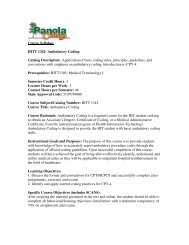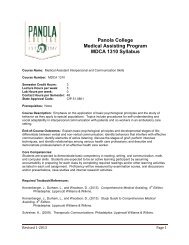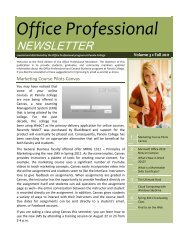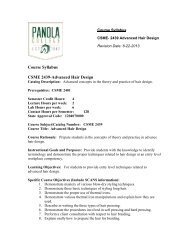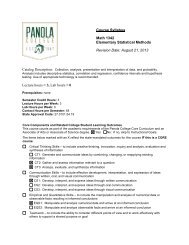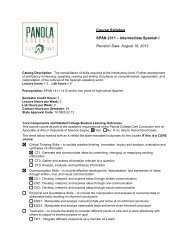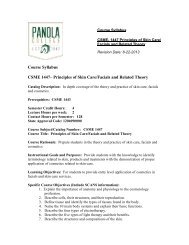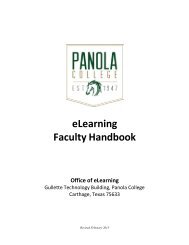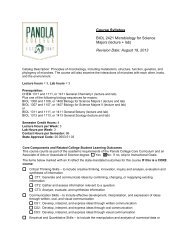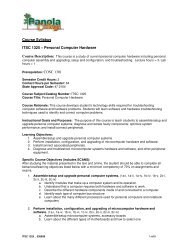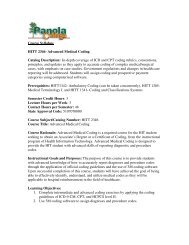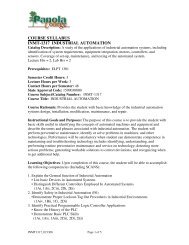Course Syllabus POFT 1301 â Business English - Panola College
Course Syllabus POFT 1301 â Business English - Panola College
Course Syllabus POFT 1301 â Business English - Panola College
You also want an ePaper? Increase the reach of your titles
YUMPU automatically turns print PDFs into web optimized ePapers that Google loves.
7. Identify and use adjectives in a sentence correctly. (1a-ii, 1b-vi, 2c-iii)<br />
a. Form the comparative and superlative degrees of regular and irregular adjectives.<br />
b. Use articles correctly.<br />
c. Use adjectives after linking verbs.<br />
d. Punctuate compound and successive independent adjectives correctly.<br />
8. Identify and use adverbs in a sentence correctly. (1a-ii, 1b-iii, 1b-vi, 2c-iii)<br />
a. Form the comparative and superlative degrees of adverbs.<br />
b. Avoid double negatives when using adverbs in a sentence.<br />
c. Use adverbs to modify verbs, adjectives, and other adverbs within a sentence.<br />
d. Identify pitfalls in the use of adverbs.<br />
9. Recognize and use prepositions in sentences. (1a-ii, 1b-iii, 1b-vi, 2c-i, 2c-iii)<br />
a. Identify prepositional phrases and label the preposition and its object(s) in each phrase.<br />
b. Avoid using prepositions in place of verbs and adverbs.<br />
c. Use troublesome prepositions correctly.<br />
d. Omit unnecessary prepositions and retain necessary ones within sentences.<br />
e. Construct formal sentences that avoid terminal prepositions.<br />
f. Recognize those words and constructions requiring specific prepositions (idioms).<br />
10. Recognize and use conjunctions in sentences. (1a-ii, 1b-vi, 2c-iii)<br />
a. Distinguish between simple and compound sentences.<br />
b. Punctuate compound sentences joined by and, or, nor, and but.<br />
c. Punctuate compounds sentences using conjunctive adverbs, such as therefore, however, and<br />
consequently.<br />
d. Recognize correlative conjunctions, such as either . . . or, not only . . . but also, and neither . . .<br />
nor.<br />
e. Use a parallel construction in composing sentences with correlative conjunctions.<br />
f. Distinguish among phrases, dependent clauses, and independent clauses.<br />
g. Expand dependent clauses into complete sentences.<br />
h. Punctuate introductory and terminal dependent clauses.<br />
i. Punctuate parenthetical, essential, and nonessential dependent clauses.<br />
j. Recognize simple, compound, complex, and compound-complex sentence patterns.<br />
k. Convert simple sentences into a variety of more complex patterns.<br />
11. Use basic punctuation rules. (1a-i, 1a-ii, 1b-iii, 1b-vi, 2c-iii)<br />
a. Insert commas correctly in series, direct address, and parenthetical expressions.<br />
b. Punctuate dates, addresses, geographical items, and appositives correctly.<br />
c. Place commas appropriately in punctuating independent adjectives, verbal phrases, and<br />
prepositional phrases.<br />
d. Use commas correctly in punctuating independent, introductory, terminal, and nonessential<br />
clauses.<br />
e. Use commas correctly in punctuating degrees, abbreviations, and numerals.<br />
f. Use commas to indicate omitted words, contrasting statements, clarity, and short quotations.<br />
g. Identify and correct errors in comma usage.<br />
h. Use semicolons correctly to join independent clauses; correct errors in such usage.<br />
i. Use semicolons correctly before enumerations and explanations; correct errors in usage.<br />
j. Use colons correctly to introduce an independent clause and to emphasize words and<br />
thoughts.<br />
k. Capitalize the first word following a colon.<br />
l. Use dashes correctly in sentences.<br />
m. Use quotation marks correctly for direct quotations, definitions, special expressions, unfamiliar<br />
terms, and titles of articles.<br />
n. Combine other punctuation marks correctly with quotation marks in sentences.<br />
12. Use basic capitalization rules. (1a-i, 1a-ii, 1b-vi)<br />
a. Use capitals correctly for the first words of sentences, direct quotations, and items in outlines.<br />
b. Use capitals correctly in headings and in titles of publications.<br />
c. Capitalize correctly proper nouns, short forms used for proper nouns, personal and official titles<br />
used with proper names, and proper adjectives.<br />
3



